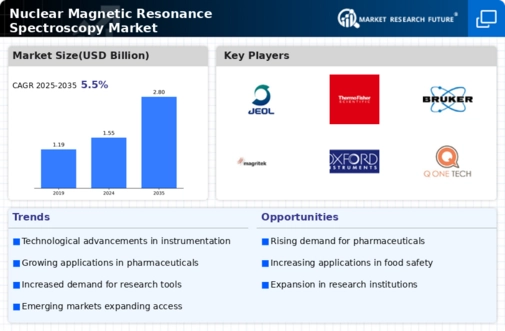Nuclear Magnetic Resonance Spectroscopy Size
Nuclear Magnetic Resonance Spectroscopy Market Growth Projections and Opportunities
NMR spectroscopy has been used extensively in the scientific community, pharmaceutical industry, and other sectors as a powerful analytical tool for studying molecule structure and composition. By using the magnetic properties of some atomic nuclei, NMR spectroscopy can provide information about detailed molecular structures of compounds. This market has expanded significantly because of the growing demand for accurate and non-destructive analytical instruments to be employed in areas such as chemistry, biochemistry as well as medical diagnostics. The range of NMR instruments available on this market include high-field NMR spectrometers, low-field NMR spectrometers portable NMR devices among others designed for specific applications. One key driver is that this technique is widely used in academic research and also pharmaceutical industry which results in growth across Nuclear Magnetic Resonance Spectroscopy Market. Molecular structures, dynamics, and interactions can be elucidated through NMR spectroscopy making it an indispensable tool to researchers involved in drug discovery material science or chemical analysis. This type of market response to rising needs for advanced versions featuring higher sensitivity levels resolution capabilities alongside automated optimization required for carrying out sophisticated analyses plus experiments. Pharmaceutical plus biotechnology firms form a significant part of the market using nuclear magnetic resonance (NMR) spectroscopy during drug development together with quality control processes. Researchers use NMR to examine protein tertiary structure and determine how they interact with potential drugs. This optimizes drug formulation; ensuring efficacy while minimizing side effects. In order to achieve enhanced analysis, the market keeps evolving meeting precise requirements within pharmaceutical field by introducing for example: cryogenic NMR probes and solid-state technologies. In the case of medical diagnostics sector, Nuclear Magnetic Resonance Spectroscopy Market contributes towards advancements made in magnetic resonance imaging (MRI). Among its numerous utilities is visualization of internal body parts since it does not involve any surgery at all using MRI; thus, avoiding various complications associated with operations on human bodies via surgeries. New developments have focused on higher magnetic field strengths, faster imaging sequences and contrast agents, all of which give physicians more specific and reliable data for diagnoses. However, there are several challenges that the market faces such as high costs of sophisticated NMR instruments and trained personnel capable of running these complex machines. Nonetheless, efforts that are on-going to develop user-friendly as well as cost effective NMR systems have been geared towards addressing these challenges; hence broadening the scope of those who can access the use of NMR spectroscopy in various industries as well it researches institutions. North America and Europe have a strong foothold in the Nuclear Magnetic Resonance Spectroscopy Market because of their established research infrastructure, high concentration of pharmaceutical/biotech companies plus academic research centers. Nevertheless, growth has been witnessed in Asia-Pacific among other emerging economies due to increased R&D activities alongside growing number of pharmaceutical plus biotech sectors hence more adoption of this technique in these regions.











Leave a Comment